
02 Jul Rarefied Air
A commercial pilot by trade, Gordon Boettger spends his free time redefining what’s possible in a sailplane over the Sierra Nevada
Late one Thursday evening, right around sunset, the manager of Steamboat Springs Airport in Colorado notices a small aircraft descending out of the sky, its sleek carbon fiber frame reflecting the purple light of dusk.
The glider touches down and comes to a stop on the empty runway. From a distance, he can see what appears to be a man in a bright red jumpsuit open the dome canopy and slide out of the cockpit as if emerging from a bobsled, his long legs clearing the side and dropping down to the asphalt. Wondering how such a tall man could fit into such a small plane, the airport manager steps outside into the cold air of early spring for a better look.
It’s not a jumpsuit, he notices, it’s an expedition suit, the type climbers wear to summit Everest. The pilot is maneuvering the glider by hand off the runway but stops when the airport manager approaches.
“Where you comin’ from?” the manager asks. Inside the cockpit is a stick and rudder system and a standard instrument panel. Less typical is the nasal cannula attached to an oxygen line leading to a tank in the back of the plane.
“Reno,” the pilot says.
“And you didn’t stop anywhere along the way?” is the question the incredulous airport manager asks, which contains by implication the one he does not ask: 700 miles in that?
The pilot wants to explain about getting hoisted behind a 200-foot towrope into the Sierra Wave 12 hours earlier, releasing from the towplane, riding the atmospheric phenomena up to 27,000 feet, navigating through harmonics of sink and lift, circumventing protected military airspace, battling spells of fatigue and surges of adrenaline, urinating through a condom catheter into a Ziploc bag, and descending at sunset in Steamboat Springs. But it’s getting late, he hasn’t eaten all day, and the only thing he has to wear is this bulky expedition suit, which is great when you’re in an unpressurized cockpit 5 miles above the earth where temperatures can fall to minus-40 degrees, but pretty unpleasant when you’re on the ground, sweating through your briefs.
“Do you happen to know where I could buy some clothes?” he asks instead.
The airport manager lends him the company car, a little beater used for errands around the airport, and points him in the direction of the only Walmart in town, which everyone here refers to with some pride as the world’s smallest Walmart, which it is not.
Of course, he gets looks from the Thursday night shoppers, ranging from the curious glance to the outright stare. Six-foot-five and handsome in a bright red survival suit and boots, striding through the aisles like he just came off a movie set or a rocket ship. He buys a cheap outfit and sneakers and sets off through town in the airport car, searching for any quiet neighborhood where he can park along an unlit curb, change out of his “everyone-look-at-me” suit, and find a place to enjoy a beer and a big dinner in peace.
It’s completely dark now, and he’s aware that this idling car looks more than a little suspicious. Porch lights have a way of coming on when he puts it in park. He drives another few blocks and tries again. His suit is around his ankles when he hears the heavy tap on the glass. “Mind telling me what’s going on here?” the cop asks him.
Gordon Boettger takes a deep breath and sighs. “Officer,” he says, “you are not going to believe this.”
Drawn by the Wind
The history of our collective fascination with soaring dates to the early myths of ancient humanity, but it wasn’t until the late nineteenth century in Germany that nascent principles of aerodynamics were applied to rudimentary gliders, and then refined in the following decades by budding aviators around the world, including the pioneering brothers Orville and Wilbur Wright.
But it was Germany that elevated the craft in the wake of World War I—in part because the Treaty of Versailles restricted the development of powered aircraft—and it is Germany that leads the design, development and recreational use of gliders today.
It is Germany, also, whose gliders Boettger flies as he redefines what is possible with unpowered flight, but it is the Sierra Nevada that puts the American wind under foreign wings.
“The Europeans are fascinated by what we’re doing out West,” says Boettger, speaking by phone from his Jacks Valley home, a short drive from the Minden-Tahoe Airport. “They call us the Minden Cowboys.”
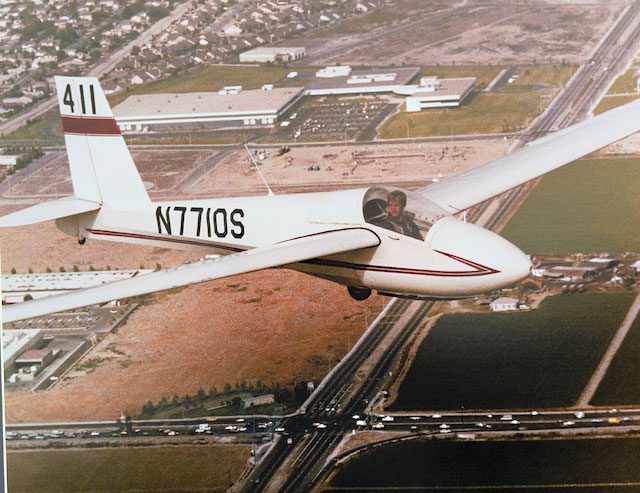
Boettger, then 14, flies over Los Alamitos in Southern California in a Schweizer 1-26, courtesy photo
It is not without cause. Along the Sierra Nevada, the winds are strong, the thermals hot and the mountain wave—referred to affectionately as “the monster”—is among the very best in the world.
“This is like the Waimea of surfing for sailplanes,” Boettger says, citing the famous surf break on the North Shore of Oahu. “That’s what’s unique about this place. A lot of airports or gliderports don’t have the luxury of both mountain wave and thermals. This is one of the top places in the world to fly.”
It’s the reason the Southern California native moved to the Carson Valley in the first place, 23 years ago, fresh off an eight-year stint as a naval aviator. Summoned to unpowered flight by the same mysterious urges that spoke to him in his youth—the son of a German pilot, then just a lanky teen setting gliding records from winch-pulls in the Los Alamitos runway and aerotows in the Mojave Desert—Boettger and his now-wife, Melissa, answered the call of the glide, “plus skiing, and hiking, and all that,” he adds, as somewhat of an afterthought.
Pushing Boundaries
Since he arrived in the area two decades ago, Boettger has been methodically chipping away at every obstacle between him and the perfect flight. It took four years just to establish Letters of Authorization with regional Air Traffic Control centers—he remains, as far as he knows, the only glider pilot in the United States to do so—which allows him to fly in Class A airspace above 18,000 feet, altitudes necessary for long-distance mountain wave gliding.
Next, he proceeded to upgrade his aircraft. First, there was the Glasflugel Kestrel 17 that carried him 699 miles in 2004 to Steamboat Springs and the local police officer who found his story too strange to be anything but true. Then, he upgraded to the Schempp-Hirth Duo Discus that took him 701 miles in 2013 to Gunnison, Colorado, 782 miles in 2014 to Casper, Wyoming, and 873 miles a few months later to Hulett, Wyoming.
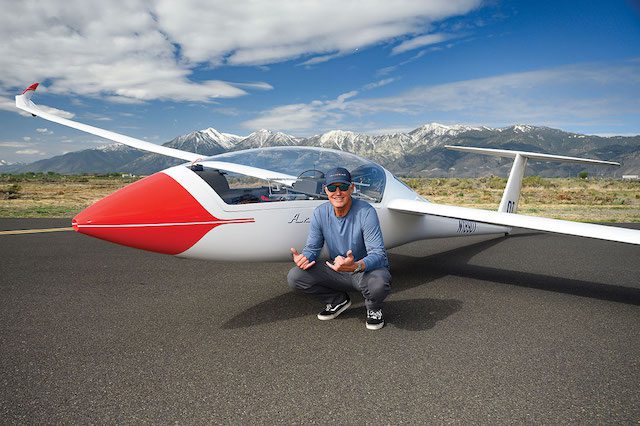
Boettger poses for a photo in front of his Schempp-Hirth Arcus J glider at the Minden-Tahoe Airport, photo by Mike Higdon
And then, in 2022, he stumbled on the chance to acquire a Schempp-Hirth Arcus J, one of only four self-launching jet sailplanes ever made. Nearly all gliders require a tow to launch, either from a winch or a plane—even a car going fast enough will do the trick—which is to say, nearly all gliders require help from another person.
When the mountain wave is roaring at 2 in the morning, the last thing a pilot wants to do is scroll through the phone wondering which friend to wake up. With the Arcus J, Boettger launches himself up to a baseline altitude of 3,000 to 4,000 feet, stows the engine and glides for as long as the winds or his body allows.
“Once I acquired the Arcus, I realized I had the weapon for these flights,” he says, speaking in great, almost wistful, detail about each component of the plane. Like its high VNE (air speak for “never exceed speed”); its high glide ratio of 50:1, which means it can travel 50 units horizontally for every one unit vertically (if you’re up a mile, you can glide 50 without any atmospheric lift); the solar panels on the fuselage, which help power the instruments by day and wingtip lights by night.
“I have the drive and the desire to expand the boundaries,” Boettger adds. “I’m asking, ‘Why are we limiting ourselves to daylight hours?’ It becomes a matter of ‘how long can you sit in that thing?’”
‘The Apotheosis of Unpowered Flight’
Disregard his years of landing on aircraft carriers in the middle of the ocean, his years of flying 777 cargo jets as a captain for FedEx, his years of aviation experience both technical and meteorological, and consider for a moment what may be Boettger’s most essential skill: his ability to squeeze an oversized body into an undersized cockpit and remain there for hours.
“You think of yourself sitting on an airplane in the middle seat and you drive yourself nuts, because you’re not doing anything,” he says. “But here, you’re constantly thinking.”

Boettger gives a thumbs-up as he partakes in his favorite pastime, photo by Mike Higdon
Thinking about the direction and force of the wind; the size, shape and density of the clouds; the presence of planes, gliders and mountain peaks; the instrument panel, the oxygen flow, the pulse oximeter paired to an app on his phone to alert him if his blood saturation is low; the distance from the nearest runway or, in a pinch, a dry lakebed; the beauty of the sunrise through his cockpit at dawn, or the splendor of the Milky Way through his military-grade night vision goggles well after dark.
In a glider, there is never a dull moment.
“What is the sky telling me?” Boettger asks rhetorically. “It’s a lot like summiting Everest. If there’s one thing that’s off, it can get very dangerous.”
Today, Boettger has done about all a human can do to achieve the apotheosis of unpowered flight: He possesses the skills and experience, he flies the world’s finest glider and he lives at the base of the Sierra Nevada, which he refers to as the “mecca for soaring.”
He has shaped his entire life around a singular vision, and in the winter of 2023, that vision set a new benchmark for glider pilots across the globe. On November 5, at 9:03 a.m., Boettger and copilot Bruce Campbell launched from the Minden-Tahoe Airport into a perfect mountain wave. They flew through the day and most of the night, and landed at 3:33 the next morning in rural Nevada, after gliding up and down the Sierra for 1,953 miles over 18.5 hours. They remain the only people ever to fly that distance in a glider.
“I think we can take it up a notch,” Boettger says.
Up a notch, to Boettger, is connecting the Sierra Wave with the mountain wave that forms over the Rockies, and landing somewhere in central Kansas when it finally gives out.
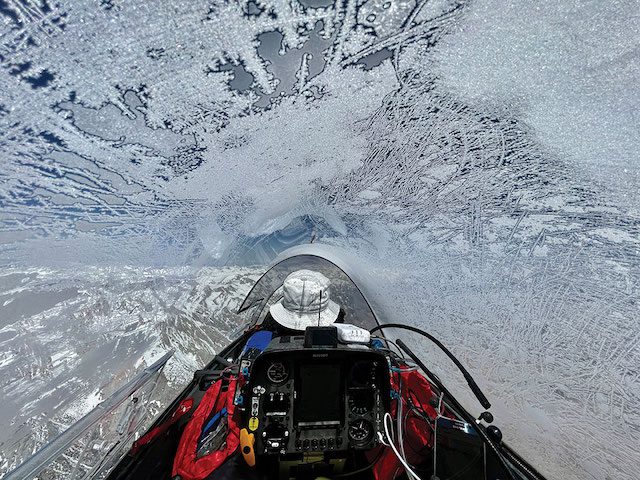
Ice forms on the canopy of Boettger’s glider during a winter flight over the Sierra, courtesy photo
“It’s hard to get a cold front system that pumps through and generates mountain wave from the Sierra all the way to the Rockies,” he says. “You might get one, maybe two, days a year that allow you to do that. On a good day, I think we can do it.”
Mike Alger, a friend of Boettger’s who retired last year after 34 years as chief meteorologist for KTVN channel 2, says finding the perfect atmospheric conditions from the Sierra all the way past the Rockies is like “catching lightning in a bottle.”
“That’s where you need that standing wave pattern downstream from the Sierra,” he says. “If you’re only getting one wave, that’s great for north to south distance records, but once you go east, if you don’t catch another wave, you can’t keep going.”
Storms that come in from the Pacific, Alger explains, rise and cool when they reach the Sierra. If the air is stable and moist, it will condense into lenticular clouds, the stationary lens-shaped formations that inspire local photographers and glider pilots alike (and are occasionally mistaken for UFOs). These clouds, often stacked like pancakes, mark the crests of mountain waves on the leeward side of the range. As the air descends and warms, then rises and cools again, a series of atmospheric ripples continues, producing lift and sink. This wave pattern persists as long as atmospheric conditions remain favorable.
“When you get those downwind wave patterns, they don’t last as long as the primary wave,” Alger says. “It’s hard to pin down how long they’ll be there. I think if Gordon hits it just right—if he can just get one more hop onto the wave in the Rockies—he might be able to do it.”
Escaping the Grind
Full-time employment is a blessing and a curse: It provides the means to afford the very thing you no longer have as much time to enjoy.
Boettger is quick to state that he has “the best job in the world,” flying cargo for FedEx, while also acknowledging the setbacks.
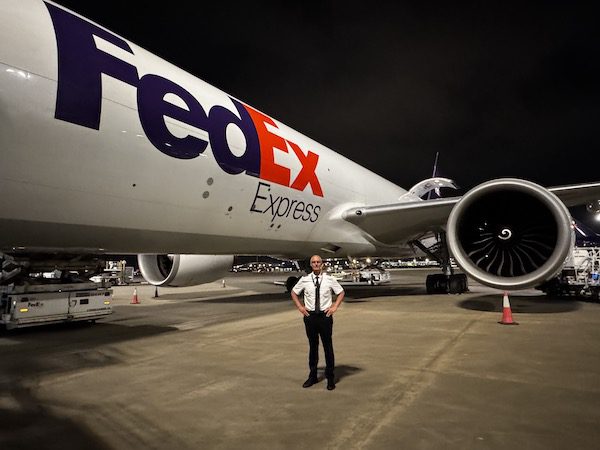
Boettger stands by a Boeing 777 in China while on the job for FedEx, courtesy photo
“It’s my job that gets in the way,” he admits. “Being on the road for a 10-day stretch on the other side of the planet and watching some good weather line up. I’ve been in a hotel room in Shanghai drooling over the satellite imagery, thinking, ‘Today was the day.’ It’s gut-wrenching to see that.”
I can relate. Staring at a computer screen, tapping keys, toggling between tabs, meeting about an email, emailing about a meeting—that is my “writing” job, which includes about as much writing as a box of Froot Loops has fruit.
When Boettger invited me to fly in his glider, I was three weeks into my new remote role at a marketing firm and had accrued no sick leave or paid time off. Already, the awareness that this job would do little to feed my creative appetite was churning in my gut. I needed to tap into something analog, off-screen, real. What could be more real than harnessing the power of the wind?
I drove the 10 hours south from Portland on a Wednesday, my work computer with me like the invasive lake weeds you read about on signs at boat docks, my pings and prompts and alerts and notifications all set to maximum volume, stopping at coffee shops along the way to address each one. I-5 was never less pleasant.
To the Sky
Gordon meets me outside the gate to his hangar in exactly the size truck you would expect, looking like a commercial about a man who can tow a plane—which he is about to do, in fact. After the full tour of the famed Arcus J, which even I can tell is a technical and aesthetic masterpiece, we hook her up to the hitch and tow her at single-digit speeds to the end of the runway.
There’s no mountain wave today, Gordon says, but we’ll have a great time chasing thermals, the rising columns of hot air marked by cumulus clouds dotting the sky on this balmy morning in early May.

Gliding over Emerald Bay, photo by Mike Higdon
“You’re probably one of, maybe, 20 people who have ever been able to fly in one of these,” he says over his shoulder as we drive. I stare out the window at the horizon, feeling the absence of my work computer like a phantom limb.
We point the glider down the runway, and Gordon remembers to give me a backpack to wear—my parachute, it turns out. “If we’re going down,” he instructs, “jump away from the plane and pull this ring out hard.” Roger that. He fits the nasal cannula around my neck and shows me how to hook the rubber in my nose. When we reach a certain altitude, the oxygen flow will kick on automatically.
I settle into my copilot’s seat in the back, and he closes the plexiglass canopy over the cockpit. We put on headsets to talk over the roar of the engine, and when the engine retracts into the frame after takeoff, to talk over the roar of the wind rushing outside the cockpit.
“If you start to feel off,” he says through the headset, somehow sounding more like a pilot than he did just a minute ago in the truck, “please just let me know. Don’t be a hero.” I promise not to be a hero, and we’re off.
The glider is light, and the turbo engine is powerful, so it doesn’t take much to get us in the air, where I can feel every ripple and nudge of the atmosphere—the difference between a glider and a commercial jet feeling like the difference between a sea kayak and an ocean liner.
“Once I feel confident that I don’t need the engine anymore, I’ll shut it off and we’ll climb up a thermal,” Gordon crackles through the headset. A moment later he says, “OK, I’m going to shut this motor down and it’s going to go silent.”
It does, and while silent is not exactly the word I would use to describe the atmosphere 5,000 feet above the ground, there is an industrial absence, like the sound of an empty house after everything you own has been loaded onto moving trucks, and you stand quietly in the center of what was once your bedroom and consider the inherent electrical noise of being a human in the twenty-first century.
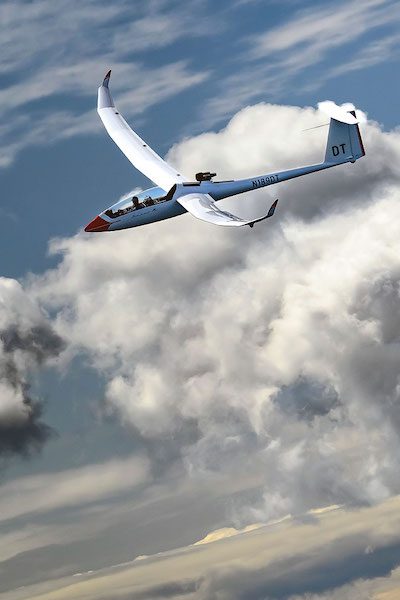
Boettger moved to the Carson Valley 23 years ago to fly gliders over the Sierra Nevada, which he fondly refers to as a “mecca for soaring,” photo by Mike Higdon
At no point in this flight will I become “one with nature” or “fly like a bird,” but I do begin to detach from what is waiting for me back online, as if moving out of range of some router and losing signal. We reach 12,000 feet and I don’t even notice that the oxygen has been flowing into my nostrils until Gordon points it out.
We hit a pocket of lift and I finally understand what he means when he says “climb a thermal.” The rising hot air nudges the glider, and Gordon pulls us into a circling turn, the variometer beeping faintly to indicate ascent as we climb what feels like a spiral staircase in the sky. Everything falls quiet as we lose speed, rising 1,000 feet per minute up this elevator of heat, which is both invisible and objectively real, a tangible fact of our planet.
The wind is strong, and as we are rising, we are also drifting, our atmospheric host being pushed eastward by the front. When we climb as high as the thermal will take us, Gordon straightens out and we head toward the next thermal, just a couple of celestial hitchhikers.
“Today we’re looking at cumulus clouds,” he says over the headset. “Which one looks the strongest? Which has the best buildup? Which has a likelihood of overdeveloping and turning into a thunderstorm?”
I see a sprawling, flat-based cumulus cloud to the west and point it out to him. Of course, Gordon has already seen it, but he still makes me feel like the star pupil.
Chasing thermals, as Alger says, “is like popcorn going off in a popcorn popper.” They’re unstable and unpredictable, especially in winds as high as we have today, which cause them to break apart. To maximize our glide time, we fly what Gordon calls the dolphin technique: rising and falling from one thermal to the next. We lose speed but gain altitude in each thermal, then gain speed and lose altitude between thermals. In theory, we could do this all day, at least until the sun sets and the thermals dissipate.
Pupil Becomes Pilot
Throughout the flight, long silences are punctuated by Gordon describing a reading from some instrument, pointing out cloud masses or simply exclaiming in awe.
“I’ve been flying since I was 13 and I’m still amazed with what we can do with these gilders,” he says. “It’s mind-blowing to me that I can fly around without an engine for almost 2,000 miles.”
What is mind-blowing to me is what he says next: “Do you want to fly?”
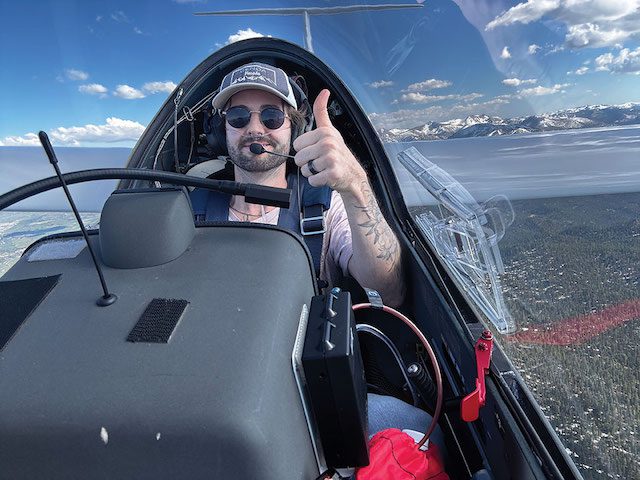
Author Michael Rohm gets the rare opportunity to pilot a Schempp-Hirth Arcus J glider, courtesy photo
Gordon keeps control of the rudders but gives me control of the stick, and just like that, I’m flying. Under a big cumulus, I feel the telltale bump, and I pull back the nose of the glider and adjust the angle to keep us spiraling. The lift is aggressive and addicting. I tighten the spiral, wanting more lift, but forget the basic principle that more lift equals less speed.
Before I realize what’s happening, Gordon says, calmy but quickly, “I’ve got the stick,” and I feel him take control and pull us out of the thermal.
“A few more seconds and we would have stalled,” he says once we have our speed back. He gives me control of the stick again, and this time I keep an eye on our speed as I angle into the next thermal. We begin to climb. I maintain an even ascent and angle, and the variometer beeps encouragingly as we rise higher into the sky.
“Great job, Mike,” Gordon says, and it’s the first time in my life I feel like a Mike. I pull out of the thermal when it breaks apart and glide down to the next one, and soon I’m directly over the Sierra Nevada, riding on ridge lift alone, which occurs when wind rises over obstacles.
At this point, Gordon embraces the role of passenger, snapping pictures, pointing out mountain peaks and ski runs, and praising my flying well out of proportion with my meager skills. But I smile for the pictures, and I accept the praise, because I am happy.
We’ve been flying for over two hours, climbing as high as 15,000 feet, when Gordon reminds me of the time, and the fact that I still plan to drive home tonight. He takes the controls, points the nose down and heads back to the Minden-Tahoe Airport, where he completes a perfect landing. We disembark. We take pictures. We slap five. As if on cue, we both look back up at the sky.
“It’s become a way of life,” Gordon says. “My eyes are always looking up.” He pauses, then continues in a rare moment of poetry. “The sky is an amazing thing. It’s amazing what we’re given with the energy that is out there. To be able to harness that without an engine—it’s remarkable.”
In the distance, a lenticular cloud appears, confirming the current forecast for mountain wave conditions in the next day or two. I will already be home by then.
Dreams of the Endless Mountain Wave
Back in Portland, I find myself looking up at the sky more. What do these clouds mean? I long to be up there again with someone who can read what I cannot, some atmospheric prophet delivering ancient wisdom to those of us trapped below the level of the cellphone towers, the static hum of economic power clogging our roads, our waterways, our offices, our bedrooms. I think daily about the moment the engine turned off, and we were simply gliding on the earth’s energy.
I call Mike Alger and ask him the question that has haunted me since the day I left the Carson Valley.
“If you take the human out of the equation,” I say, “the need to eat, to sleep, to use the bathroom—could a glider stay up forever?”
In his long silence I hear a gust of wind coming through the phone, as if he actually stepped outside to evaluate the sky. I wonder if my question is the meteorological equivalent of asking a pastor if heaven is real.
Alger sighs. “Infinitely, no,” he finally says. “The thing is, those waves don’t last forever. Even if you take out the human, at some point you’re going to lose lift, and you’re not going to get it again. Infinite is not in the cards.”
I want to believe in wave conditions that never end, thermals that never break up and fade away, a sailplane that never lands, a pilot who never has to return to earth. I think of Ray Bradbury’s The Rocket Man, about a planetary explorer who comes home to his family after each long deployment, only to launch back into space a few days later.
“I could see his profile tilted back, and he was watching the stars wheel over the sky,” the young narrator in the story says of his father. “His eyes were like gray crystal there, the moon in each one.”
Gordon Boettger lives a complete life and does not fly at the expense of his family, though they are aware that “everything would get dropped,” he says, for a rare day of perfect mountain wave conditions.
“I don’t know if that drive will ever go away,” he adds. “I don’t know what I would do if I wasn’t able to fly a sailplane.”
That day will eventually come, but for now, it is enough to ride the wave when it’s there—and to look at the sky, with a moon in each eye, when it’s gone.
Michael Rohm lives in Portland, where he makes music when he’s not busy working as a communications strategist, whatever that is.




Frauke Elber
Posted at 05:17h, 12 Julyabsolutely beautiful
Timothy Temple-Watts
Posted at 00:49h, 21 JulyWonderfully written, thank you.
R. H.
Posted at 13:44h, 26 JulyFascinating, excellent story!
R. H.
Posted at 13:45h, 26 JulyAwesome photos !